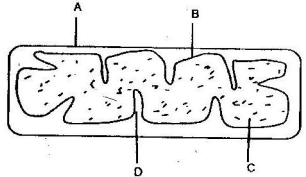Questions
- The diagram below shows a set up that was used to demonstrate fermentation.
Glucose solution was boiled and oil added on top of it. The glucose solution was then allowed to cool before adding the yeast suspension.- Why was the glucose solution boiled before adding the yeast suspension? (1mk)
- What was the importance of cooling the glucose solution before adding the yeast suspension? (1mk)
- What was the use of the oil in the experiment? (1mk)
- What observation would be made in test tube B at the end of the experiment (1mk)
- Suggest a control for this experiment (1mk)
- Give two reasons why accumulation of lactic acid during vigorous exercise lead to an increase in heart beat. (2mks)
- A process that occurs in plants is represented by the equation below.
C6H12O6 → 2C2H5OH + (2CO2) + Energy
Glucose Ethanol Carbon Dioxide- Name the process (1mk)
- State the economic importance of process name in (a) above. (1mk)
- Other than carbon dioxide, name the other products of anaerobic respiration in plants. (2mks)
- Name the substance which accumulates in muscles when respiration occurs with insufficient oxygen. (1mk)
-
- In what form is energy stored in muscles? (1mk)
- State the economic importance of anaerobic respiration in plants. (2mks)
- State four ways in which respiratory surfaces are suited to their function. (4mks)
-
- A dog weighing 15.2kg requires 216kJ while a mouse weighing 50g requires 2736KJ per day. Explain. (2mks)
- What is the end product of respiration in animals when there is insufficient oxygen supply? (1mk)
-
- Name the products of anaerobic respiration in:
- Plants (1mk)
- Animals (1mk)
- What is oxygen debt? (1mk)
- Name the products of anaerobic respiration in:
- 2C51H98O6 + 145O2 → 102CO2 + 98 H2O + energy
The above equation shows an oxidation reaction of food substances.- What do you understand by the term respiratory quotient? (1mk)
- Determine respiratory quotient of the oxidation of food substance. (2mks)
- Identify the food substances. (1mk)
- Write differences between aerobic respiration and photosynthesis. (4mks)
- Below is a diagram of an organelle that is involved in aerobic respiration.
- Name the organelle (1mk)
- Name the parts labeled A, B, and C. (3mks)
- What is the purpose of the folding labeled D? (1mk)
- Give the chemical compound which is formed in the organelle and forms the immediate source of energy.
Answers
-
- To derive off air or oxygen
- To avoid killing yeast/Denaturing enzymes in yeast
- To prevent air from getting into the yeast and glucose mixture.
- Lime water turn to white precipitate
- Use boiled yeast/glucose without yeast/yeast without glucose
- - Lactic acid is toxic to tissues and must be removed from muscles to liver.
- To increase supply of oxygen to tissues -
- Anaerobic respiration
- Brewing/Beer making
- - Ethanol
- Energy (ATP) - - Lactic acid
-
- Adenosine triphosphate (ATP)
- Beer brewing/wine making
- Baking using yeast.
- - Have thin epithelium/wall to reduce distance of diffusion of the gases.
- Moist to dissolve the diffusing gases
- Highly folded to increase surface area for diffusion of gases.
- Well supplied with blood or vascularized to help maintain high concentration gradient. -
- A mouse has high surface area to volume ratio and tends to lose heat faster. It required more energy to replace it.
A dog has low surface area to volume ratio and lose less heat. Less energy is required to replace it - Lactic acid
- A mouse has high surface area to volume ratio and tends to lose heat faster. It required more energy to replace it.
-
-
- Ethanol and carbon (IV) oxide.
- Lactic acid
- It is the state when human body undergoes anaerobic respiration producing lactic acid. Oxygen has to be taken into the body to break the lactic acid.
-
-
- Ratio of carbon dioxide produce to oxygen used up during breakdown of a food substrate.
- R.Q = CO2 produced
O2 used up
R.Q = 102/145
R.Q = 0.7 - Fat/ Lipid
-
Aerobic respiration Photosynthesis - Take place in both plants and animals
- Takes place in all body cells
- Takes place during the day and night
- Oxygen is taken up while carbon
dioxide is removed.- Only takes place in plants.
- Takes place in cells containing chloroplast
- Takes place during the day only.
- Carbon dioxide used up while oxygen is
given off. -
- Mitochondrion
- A - Outer membrane
B - Inner membrane
C - Matrix
D - Cristae - Increase surface area over which respiration takes place:
- ATP
Join our whatsapp group for latest updates
Tap Here to Download for 50/-
Get on WhatsApp for 50/-
Download Respiration Questions and Answers - Biology Form 2 Topical Revision.
Tap Here to Download for 50/-
Get on WhatsApp for 50/-
Why download?
- ✔ To read offline at any time.
- ✔ To Print at your convenience
- ✔ Share Easily with Friends / Students



